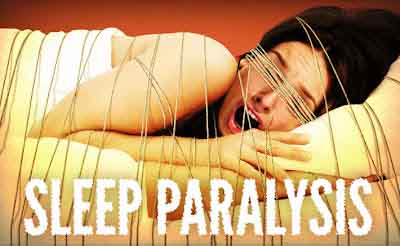Sleep Paralysis
Sleep Paralysis

Have you ever woken up, unable to move, paralyzed by fear? There can be any number of reasons people suddenly awaken from sleep and feel physically paralyzed. In the realms of metaphysics we associated this phenomenon with visitations. The alien abduction experience generally occurs at night, often when the person is sleeping. They awaken, frightened (scared stiff) and seemingly paralyzed either by their intruders or their emotions. They later report seeing any number of things from aliens (usually grays), spirits (sometimes angelic, other times demonic with a sexual agenda), or floating objects of light (generally orbs) in their room. The feeling of paralysis can last briefly or seemed prolonged. If another person is sleeping in the room, they may seem unaffected as they toss and turn in bed.
There are many causes of sleep paralysis, physical but also not-so-physical, such as being awakened suddenly when your consciousness has not fully integrated back into your physical body. This often results in physical symptoms of nausea and disorientation – by coming back into the body too quickly. Remember that only part of our experience is in 3D Earth physical reality grid. There is so much more, interesting experiences simultaneously occurring in other grids realities (subroutines of the program.) You are much more than the person sitting in that chair reading this.
Sleep paralysis for some goes to involuntary (and often scary) unexpected floating out of the physical body for any number of Out of Body experiences, usually astral projection.
Articles about Alien Abductions and Sleep Paralysis
- Alien Abduction Skeptics Dictionary
- Alien Abduction: Hunk Science calls it Sleep Paralysis — Budd Hopkins – Intruders Foundation
- Abduction by Aliens or Sleep Paralysis? Committee for Skeptical Inquiry 1998
- Alien abduction claims explained: Sleep paralysis, false memories involved Susan Clancy Harvard Gazette
The Alien Abduction Phenomenon Wikipedia
- The abduction phenomenon is an umbrella term used to describe a number of hypotheses, claims, or assertions stating that non-human creatures (usually aliens) kidnap individuals – sometimes called “abductees” – usually for medical testing or for sexual reproduction procedures. Many such encounters are described as terrifying or humiliating, but others describe them as transformative or even pleasant. Reports of the abduction phenomenon have been made from around the world, but have perhaps seen most mainstream attention in the United States.Skeptics tend to doubt that the phenomenon occurs literally as reported, and a wide variety of alternate explanations have been proposed. Rather, such skeptics often argue that the phenomenon might be characterised as a type of modern-day folk myth (like the historic belief in vampires). The alien abduction phenomenon has been the subject of conspiracy theory and as such has become a staple of popular science fiction works such as The X-Files.
On the Matter of Sleep Paralysis in general: Sleep Paralysis Wikipedia
-
- Sleeping in a supine position (facing upwards)
- Irregular sleeping schedules; naps, sleeping in, sleep deprivation
- Increased stress
- Sudden environmental/lifestyle changes
- A lucid dream that immediately precedes the episode. Also conscious induction of sleep paralysis is a common technique to enter a state of lucid dreams, also known as WILD .
- Artificial sleeping aids, ADD medications and/or antihistamines
Sleep paralysis is a condition characterized by temporary paralysis of the body shortly after waking up (known as hypnopompic paralysis) or, less often, shortly before falling asleep (known as hypnagogic paralysis).Physiologically, it is closely related to the paralysis that occurs as a natural part of REM (rapid eye movement) sleep, which is known as REM atonia. Sleep paralysis occurs when the brain awakes from a REM state, but the bodily paralysis persists. This leaves the person fully aware, but unable to move. In addition, the state may be accompanied by hypnagogic hallucinations.
More often than not, sleep paralysis is believed by the person affected by it to be no more than a dream. This explains many dream recountings which describe the person lying frozen and unable to move. The hallucinatory element to sleep paralysis makes it even more likely that someone will interpret the experience as a dream, since completely fanciful objects may appear in the room alongside one’s normal vision.
The primary symptom of sleep paralysis is partial or complete skeletal muscle paralysis during the hypnopompic or hypnagogic states. In other words, it is the sense of being aware that one is unable to move or speak while falling asleep or waking up. Sleep paralysis may also be accompanied by hypnagogic hallucinations. These hallucinations can be auditory, tactile, and/or visual. If a polysomnograph is taken, at least one of the following will be shown: skeletal muscle tone suppression, REM sleep at sleep onset, or dissociated REM sleep. The paralysis can persist anywhere from a few seconds to a few minutes before the person is able to either return to REM sleep or to become fully awake.
Possible Causes
Sleep paralysis occurs during REM sleep in order to prevent the body from manifesting movements made in the subject’s dreams. Very little is known about the physiology of sleep paralysis. However, some have suggested that it may be linked to post-synaptic inhibition of motor neurons in the pons region of the brain. In particular, low levels of melatonin may stop the depolarization current in the nerves, which prevents the stimulation of the muscles, to prevent the body from enacting the dreamt activity (e.g. preventing a sleeper from flailing his legs when dreaming about running).
Many people who commonly enter sleep paralysis also suffer from narcolepsy. However, various studies suggest that many or most people will experience sleep paralysis at least once or twice in their lives. Some reports read that various factors increase the likelihood of both paralysis and hallucinations. These include:
Treatment
During paralysis episodes, patients may be advised to try moving the facial muscles and moving eyes from one side to the other. This may hasten the termination of the attack. Clonazepam is highly effective in the treatment of sleep paralysis. The initial dose is 0.5 mg at bedtime, while an increase to 1 mg per night might be necessary to maintain potency. Anecdotal reports indicate SSRIs such as fluoxetine markedly decrease the incidence of sleep paralysis. Several people who have been both on and off SSRIs have reported corresponding decreases and increases in sleep paralysis episodes. Others report no effects at all.






